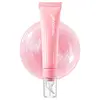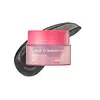What's inside
What's inside
 Key Ingredients
Key Ingredients

 Benefits
Benefits

 Concerns
Concerns

 Ingredients Side-by-side
Ingredients Side-by-side

Hydrogenated Polyisobutene
EmollientPolyisobutene
Hydrogenated Poly(C6-14 Olefin)
EmollientDiisostearyl Malate
EmollientCaprylic/Capric Triglyceride
MaskingHydrogenated Castor Oil Dimer Dilinoleate
Skin ConditioningEthylene/Propylene/Styrene Copolymer
Hydrogenated Palm Oil
EmollientHydrogenated Rapeseed Oil
EmollientSilica Dimethyl Silylate
EmollientParfum
MaskingCalcium Titanium Borosilicate
AbrasiveGlyceryl Caprylate
EmollientButylene/Ethylene/Styrene Copolymer
Caprylyl Glycol
EmollientPentaerythrityl Tetra-Di-T-Butyl Hydroxyhydrocinnamate
AntioxidantWater
Skin ConditioningTitanium Dioxide
Cosmetic ColorantPolyglyceryl-2 Isostearate
EmulsifyingTocopherol
AntioxidantDipentaerythrityl Hexahydroxystearate
EmulsifyingCI 15850
Cosmetic Colorant1,2-Hexanediol
Skin ConditioningSodium Dna
Skin ConditioningTin Oxide
AbrasiveButyrospermum Parkii Butter
Skin ConditioningCeramide NP
Skin ConditioningAcetyl Hexapeptide-8
HumectantCopper Tripeptide-1
Skin ConditioningPalmitoyl Pentapeptide-4
Skin ConditioningPalmitoyl Hexapeptide-12
Skin ConditioningSodium Hyaluronate
HumectantHydroxypropyltrimonium Hyaluronate
Hydrolyzed Hyaluronic Acid
HumectantSodium Acetylated Hyaluronate
HumectantHyaluronic Acid
HumectantHydrolyzed Sodium Hyaluronate
Skin ConditioningSodium Hyaluronate Crosspolymer
HumectantPotassium Hyaluronate
Skin ConditioningHydrogenated Polyisobutene, Polyisobutene, Hydrogenated Poly(C6-14 Olefin), Diisostearyl Malate, Caprylic/Capric Triglyceride, Hydrogenated Castor Oil Dimer Dilinoleate, Ethylene/Propylene/Styrene Copolymer, Hydrogenated Palm Oil, Hydrogenated Rapeseed Oil, Silica Dimethyl Silylate, Parfum, Calcium Titanium Borosilicate, Glyceryl Caprylate, Butylene/Ethylene/Styrene Copolymer, Caprylyl Glycol, Pentaerythrityl Tetra-Di-T-Butyl Hydroxyhydrocinnamate, Water, Titanium Dioxide, Polyglyceryl-2 Isostearate, Tocopherol, Dipentaerythrityl Hexahydroxystearate, CI 15850, 1,2-Hexanediol, Sodium Dna, Tin Oxide, Butyrospermum Parkii Butter, Ceramide NP, Acetyl Hexapeptide-8, Copper Tripeptide-1, Palmitoyl Pentapeptide-4, Palmitoyl Hexapeptide-12, Sodium Hyaluronate, Hydroxypropyltrimonium Hyaluronate, Hydrolyzed Hyaluronic Acid, Sodium Acetylated Hyaluronate, Hyaluronic Acid, Hydrolyzed Sodium Hyaluronate, Sodium Hyaluronate Crosspolymer, Potassium Hyaluronate
Petrolatum
EmollientPolybutene
Bis-Diglyceryl Polyacyladipate-2
EmollientMethyl Hydrogenated Rosinate
PerfumingMicrocrystalline Wax
Emulsion StabilisingSilica
AbrasiveSilica Silylate
EmollientSericin
Skin ConditioningTridecyl Trimellitate
EmollientEclipta Prostrata Extract
Skin ConditioningEclipta Prostrata Leaf Extract
Skin ConditioningMelia Azadirachta Leaf Extract
Skin ConditioningMelia Azadirachta Flower Extract
Skin ConditioningMoringa Oleifera Seed Oil
EmollientCoccinia Indica Fruit Extract
Skin ConditioningAloe Barbadensis Flower Extract
EmollientSolanum Melongena Fruit Extract
Skin ConditioningSimmondsia Chinensis Seed Oil
EmollientCorallina Officinalis Extract
Skin ConditioningCurcuma Longa Root Extract
MaskingOcimum Sanctum Leaf Extract
Skin ConditioningOryza Sativa Extract
AbsorbentPseudoalteromonas Ferment Extract
HumectantSesamum Indicum Seed Extract
Skin ConditioningGlycine Max Seed Extract
Skin ConditioningRubus Fruticosus Fruit Extract
AstringentDiglyceryl Sebacate/Isopalmitate
EmollientOctyldodecanol
EmollientPolyethylene
AbrasiveTocopheryl Acetate
AntioxidantAdenosine
Skin ConditioningCaprylyl Glycol
EmollientGlyceryl Caprylate
EmollientWater
Skin ConditioningEthylhexyl Palmitate
EmollientButylene Glycol
HumectantGlycerin
HumectantTribehenin
EmollientSorbitan Isostearate
EmulsifyingLactic Acid
BufferingEthylhexylglycerin
Skin ConditioningAlanine
MaskingPalmitoyl Tripeptide-1
Skin ConditioningProline
Skin ConditioningSerine
MaskingSodium Phosphate
BufferingSodium Hydroxide
BufferingXanthan Gum
EmulsifyingParfum
MaskingPetrolatum, Polybutene, Bis-Diglyceryl Polyacyladipate-2, Methyl Hydrogenated Rosinate, Microcrystalline Wax, Silica, Silica Silylate, Sericin, Tridecyl Trimellitate, Eclipta Prostrata Extract, Eclipta Prostrata Leaf Extract, Melia Azadirachta Leaf Extract, Melia Azadirachta Flower Extract, Moringa Oleifera Seed Oil, Coccinia Indica Fruit Extract, Aloe Barbadensis Flower Extract, Solanum Melongena Fruit Extract, Simmondsia Chinensis Seed Oil, Corallina Officinalis Extract, Curcuma Longa Root Extract, Ocimum Sanctum Leaf Extract, Oryza Sativa Extract, Pseudoalteromonas Ferment Extract, Sesamum Indicum Seed Extract, Glycine Max Seed Extract, Rubus Fruticosus Fruit Extract, Diglyceryl Sebacate/Isopalmitate, Octyldodecanol, Polyethylene, Tocopheryl Acetate, Adenosine, Caprylyl Glycol, Glyceryl Caprylate, Water, Ethylhexyl Palmitate, Butylene Glycol, Glycerin, Tribehenin, Sorbitan Isostearate, Lactic Acid, Ethylhexylglycerin, Alanine, Palmitoyl Tripeptide-1, Proline, Serine, Sodium Phosphate, Sodium Hydroxide, Xanthan Gum, Parfum
Ingredients Explained
These ingredients are found in both products.
Ingredients higher up in an ingredient list are typically present in a larger amount.
Caprylyl Glycol is a humectant and emollient, meaning it attracts and preserves moisture.
It is a common ingredient in many products, especially those designed to hydrate skin. The primary benefits are retaining moisture, skin softening, and promoting a healthy skin barrier.
Though Caprylyl Glycol is an alcohol derived from fatty acids, it is not the kind that can dry out skin.
This ingredient is also used as a preservative to extend the life of products. It has slight antimicrobial properties.
Learn more about Caprylyl GlycolGlyceryl Caprylate comes from glycerin and caprylic acid, a fatty acid from coconut. It has emollient and emulsifier properties.
As an emollient, it helps hydrate your skin. Emollients work by creating a barrier on your skin to trap moisture in, helping to keep your skin soft and smooth.
On the other hand, emulsifiers prevent ingredients (such as oil and water) from separating.
Learn more about Glyceryl CaprylateParfum is a catch-all term for an ingredient or more that is used to give a scent to products.
Also called "fragrance", this ingredient can be a blend of hundreds of chemicals or plant oils. This means every product with "fragrance" or "parfum" in the ingredients list is a different mixture.
For instance, Habanolide is a proprietary trade name for a specific aroma chemical. When used as a fragrance ingredient in cosmetics, most aroma chemicals fall under the broad labeling category of “FRAGRANCE” or “PARFUM” according to EU and US regulations.
The term 'parfum' or 'fragrance' is not regulated in many countries. In many cases, it is up to the brand to define this term.
For instance, many brands choose to label themselves as "fragrance-free" because they are not using synthetic fragrances. However, their products may still contain ingredients such as essential oils that are considered a fragrance by INCI standards.
One example is Calendula flower extract. Calendula is an essential oil that still imparts a scent or 'fragrance'.
Depending on the blend, the ingredients in the mixture can cause allergies and sensitivities on the skin. Some ingredients that are known EU allergens include linalool and citronellol.
Parfum can also be used to mask or cover an unpleasant scent.
The bottom line is: not all fragrances/parfum/ingredients are created equally. If you are worried about fragrances, we recommend taking a closer look at an ingredient. And of course, we always recommend speaking with a professional.
Learn more about ParfumWater. It's the most common cosmetic ingredient of all. You'll usually see it at the top of ingredient lists, meaning that it makes up the largest part of the product.
So why is it so popular? Water most often acts as a solvent - this means that it helps dissolve other ingredients into the formulation.
You'll also recognize water as that liquid we all need to stay alive. If you see this, drink a glass of water. Stay hydrated!
Learn more about Water